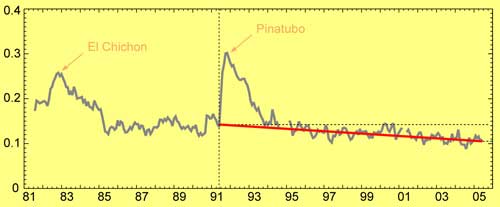More water vapor released into the atmosphere generates more cloud cover, cooling the planet and allowing the oceans to absorb more water vapor, thereby...etc, etc, etc. In other words, the planetary climate is self-regulating (an amazing design, from an engineering standpoint).
"Recent reversal of the trend
Sun-blocking aerosols around the world steadily declined (red line) since the 1991 eruption of Mount Pinatubo, according to satellite estimates. Credit: Michael Mishchenko, NASAWild et al. using measurements over land report brightening since 1990.[27][9][28] and Pinker et al.[29] found that slight dimming continued over land while brightening occurred over the ocean.[30] Hence, over the land surface, Wild et al and Pinker et al disagree. A 2007 NASA sponsored satellite-based study sheds light on the puzzling observations by other scientists that the amount of sunlight reaching Earth's surface had been steadily declining in recent decades, suddenly started to rebound around 1990. This switch from a "global dimming" trend to a "brightening" trend happened just as global aerosol levels started to decline.[31][26]
It is likely that at least some of this change, particularly over Europe, is due to decreases in pollution. Most governments of developed nations have done more to reduce aerosols released into the atmosphere, which helps reduce global dimming, than to reduce CO2 emissions.
Sulfate aerosols have declined significantly since 1970 with the Clean Air Act in the United States and similar policies in Europe. The Clean Air Act was strengthened in 1977 and 1990. According to the EPA, from 1970 to 2005, total emissions of the six principal air pollutants, including PM’s, dropped by 53 percent in the US. In 1975, the masked effects of trapped greenhouse gases finally started to emerge and have dominated ever since.[32]
The Baseline Surface Radiation Network (BSRN) has been collecting surface measurements. BSRN was started in the early 1990s and updated the archives in this time. Analysis of recent data reveals that the surface of the planet has brightened by about 4% in the past decade. The brightening trend is corroborated by other data, including satellite analyses."

Relationship to hydrological cycle
This figure shows the level of agreement between a climate model driven by five factors and the historical temperature record. The negative component identified as "sulfate" is associated with the aerosol emissions blamed for global dimming.Further information: Hydrological cycle
Pollution produced by humans may be seriously weakening the Earth's water cycle - reducing rainfall and threatening fresh water supplies. A 2001 study by researchers at the Scripps Institution of Oceanography suggests that tiny particles of soot and other pollutants have a significant effect on the hydrological cycle. "The energy for the hydrological cycle comes from sunlight. As sunlight heats the ocean, water escapes into the atmosphere and falls out as rain. So as aerosols cut down sunlight by large amounts, they may be spinning down the hydrological cycle of the planet." according to prof. V. Ramanathan.[33]
Large scale changes in weather patterns may also have been caused by global dimming. Climate models speculatively suggest that this reduction in sunshine at the surface may have led to the failure of the monsoon in sub-Saharan Africa during the 1970s and 1980s, together with the associated famines such as the Sahel drought, caused by Northern hemisphere pollution cooling the Atlantic.[34] Because of this, the Tropical rain belt may not have risen to its northern latitudes, thus causing an absence of seasonal rains. This claim is not universally accepted and is very difficult to test.
It is also concluded that the imbalance between global dimming and global warming at the surface leads to weaker turbulent heat fluxes to the atmosphere. This means globally reduced evaporation and hence precipitation occur in a dimmer and warmer world, which could ultimately lead to a more humid atmosphere in which it rains less.[35]
A natural form of large scale environmental shading/dimming has been identified that affected the 2006 northern hemisphere hurricane season. The NASA study found that several major dust storms in June and July in the Sahara desert sent dust drifting over the Atlantic Ocean and through several effects caused cooling of the waters - and thus deadening the development of hurricanes.[36][37]
Possible use to mitigate global warming
Some scientists have suggested using aerosols to stave off the effects of global warming as an emergency measure. Russian expert Mikhail Budyko understood this relationship very early on. In 1974, he suggested that if global warming became a problem, we could cool down the planet by burning sulfur in the stratosphere, which would create a haze.[42][43][44] According to Ramanathan (1988), an increase in planetary albedo of just 0.5 percent is sufficient to halve the effect of a CO2 doubling.[45]
However, we would still face many problems, such as:
*Using sulfates causes environmental problems such as acid rain[46]
*Using carbon black causes human health problems[46]
*Dimming causes ecological problems such as changes in evaporation and rainfall patterns[46]
*Droughts and/or increased rainfall cause problems for agriculture[46]
Aerosol has a relatively short lifetime
"Ideas that we should increase aerosol emissions to counteract global warming have been described as a 'Faustian bargain' because that would imply an ever increasing amount of emissions in order to match the accumulated greenhouse gas in the atmosphere, with ever increasing monetary and health costs."[47] In essence, the sources of both greenhouse gases and air particulates must be addressed."
http://en.wikipedia.org/wiki/Global_dimming(If anyone thinks this material strengthens their argument - no matter what your argument is - then by all means thank me instead of inventing a reason to get defensive. Thank you.)
